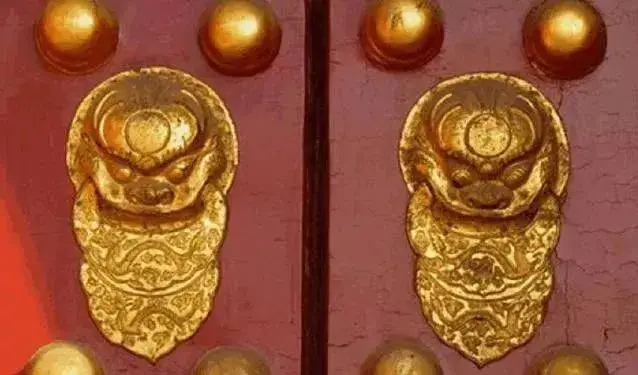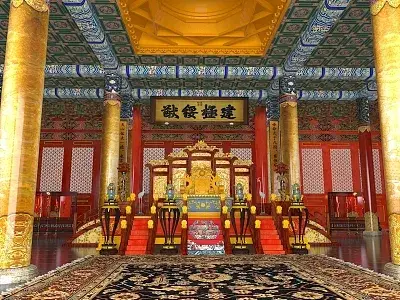Table of Contents
2025 The Forbidden City at 600: Decoding the Human Stories Within an Imperial Palace

I Frozen Order: The Poetics of Power in Architectural Language
1. The Central Axis as Spiritual Totem
Stretching 7.8 km from Yongding Gate to the Bell and Drum Towers, the central axis is a silver needle threading through dynastic rise and fall, with the Forbidden City as its eye. The 1,344 golden dragons in the Hall of Supreme Harmony’s caisson ceiling, the 250-ton Cloud-Dragon Stone behind the Hall of Preserving Harmony, and the secret edict box behind the “Upright and Bright” plaque in the Palace of Heavenly Purity—every dimension calibrates imperial authority.2. Cosmic Dialogues in Numbers
- 9,999.5 rooms: Half a room fewer than the celestial emperor’s abode, a gesture of mortal humility.
- Five Elements & Colors: Yellow tiles (earth) dominate the center; green tiles (wood) guard the Hall of Literary Brilliance.
- Gate Nail Code: 81 brass nails (9×9), except at Donghua Gate—one row missing, echoing the heir’s “deference” philosophy.


II. Crimson Silks: Survival Games in the Inner Court
1. Concubines’ Calculus of Survival
Jade mahjong in the Palace of Earthly Honor, fertility goddesses in the Palace of Great Benevolence, hidden walls in the Cold Palace—each space maps women’s fates. Empress Dowager Cixi curated 24 “virtuous women” murals in the Palace of Eternal Spring for indoctrination. The 30 cm-wide Zhenfei Well still whispers with the cries of reformists.2. Eunuchs’ Shadow Empire
From the Directorate’s vermilion-inked decrees to the imperial kitchen’s silver poison-testing plates, eunuchs wove webs of power. Wei Zhongxian embedded copper tubes in the Directorate to eavesdrop; Li Lianying’s jade pipe hid a spyglass—castrated bodies harboring uncastrated ambitions.
III. Craftsmanship Code: Civilization’s DNA in Mortise and Tenon
1. The “Yangshi Lei” Architectural Magic
Seven generations of the Lei family designed imperial buildings. Their 18,000 surviving tangyang (architectural models), made from sorghum stalks and paper, preserve architectural souls. The Hall of Supreme Harmony’s inward-leaning pillars (2.5% tilt) defy earthquakes.2. Golden Bricks’ Odyssey
Suzhou’s “golden bricks”—”ring like jade, unbroken when split”—underwent 29 steps: soil selection, mud refining, shade-drying. Laid with tung oil and polished with boys’ urine, each brick encapsulates three years of a craftsman’s life.
IV. Artifacts as China’s Spiritual Chronicle
1. A Thousand Li of Rivers and Mountains: An 18-Year-Old’s Masterpiece
Wang Ximeng poured his life into this 12-meter Song Dynasty scroll in six months. Ground malachite and lapis lazuli pigments still gleam like gemstones, capturing scholars’ utopia of “recluse within palace walls.”2. Clock Gallery’s Mechanical Prophecies
Among Qianlong’s 2,000 Western clocks, the “Writing Automaton Clock” inscribes “All lands submit to the emperor.” When gears turn, mechanical birds sing—the Industrial Revolution’s prelude echoing through imperial twilight.

V. Beyond the Walls: The Forbidden City’s Cultural Legacy
1. Imperial Kitchen’s Flavor Politics
The mythical “Manchu-Han Banquet” (108 dishes) was fiction. Reality: Kangxi ate two daily meals, favoring cabbage stew; Qianlong imported Jiangsu pork; Cixi’s menus featured chrysanthemum hotpot and rose jam.2. The Great Cultural Exodus: 1933
13,000 crates fled the war via oxcarts, junks, and trains. Bronzes swaddled in quilts, paintings hidden in coal piles. When a Complete Library of the Four Treasuries crate plunged into a ravine, scholars rescued pages by torchlight.
VI. The New Forbidden City: From Imperial Residence to Global Heritage
1. Digital Resurrection
VR recreates Empress Dowager Cixi’s “screen governance” in the Hall of Mental Cultivation; 3D-printed murals revive the Pavilion of Exhaustion from Diligence; CT scans expose Five Oxen’s millennium-old scars.2. Guardians of the New Era
Shan Jixiang logged 9,371 rooms to create artifact “medical records”; restorer Wang Jin adjusts clock gears by 0.01mm; storytellers viralize history on Douyin.
The Forbidden City’s Human Code At sunset, as the 600,000th crimson glow gilds its walls, this 599-year-old palace still converses with civilizations:
- Each of the 2 million bricks in the Hall of Supreme Harmony square bears a craftsman’s fingerprint.
- Three layers of rice paper are soaked with Yongzheng’s edict ink in the Grand Council chamber.
- The Ruins of the Crystal Palace nurture apple trees planted by Puyi.

- Observe the winter solstice sundial projection at the Hall of Supreme Harmony.
- Hunt Qing-era graffiti on Western Six Palaces’ walls.
- Sip the “A Thousand Li of Rivers and Mountains” roll at the Corner Tower Café.
- Immerse yourself in the “600 Years of the Forbidden City” digital exhibition.
When the wind whispers through vermilion gates, it carries six centuries of secrets—now yours to unravel. 🏯🔍


